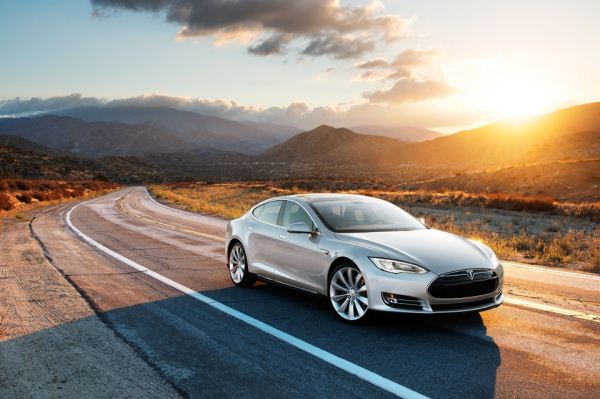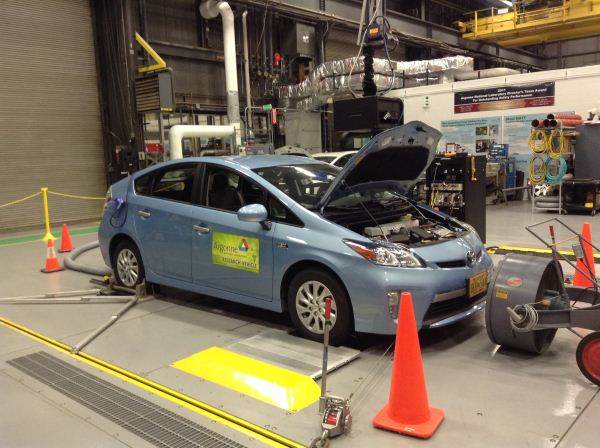The Tesla Model S Controversy: Understanding the Effects of Temperature on Electric Vehicle Efficiency and Range
by Vivek Gowri on February 18, 2013 4:22 PM EST- Posted in
- Auto
- Electric Vehicles
- Tesla Model S
- Nissan Leaf
Thus far, plenty of ink has been spilled regarding the Tesla Model S and the fallout from the New York Times article, and it even showed up in our latest podcast. I feel like my perspective on this topic, as someone who has worked in the EV space as an engineer for the last four years, as well as driving a family owned Nissan Leaf for the last year and a half, is a bit different from our editors who discussed it, as well as most of the others who have written about it.
I’m not particularly interested in getting involved with the back and forth or analyzing what either party said - I feel like the Times reporter didn’t really understand how EVs work, nor how to drive them, and I don’t really agree with Elon Musk’s Matlab data infused response (it felt too vitriolic to get across any point other than Tesla being angry about the article). And just to go back to the point about not understanding how EVs should be driven, you have to tailor your driving style to suit the powertrain in order to get the maximum out of the EV - if you don’t want to, you’re going to be disappointed. Consider it like needing to switch keyboard shortcuts when you move from Windows to OS X - it’s a slight mental recalibration that has to happen for you to use the platform to its fullest. But that’s another story for another time.
What I feel like is getting lost here is actual EV performance in cold weather, or hot weather, or really anything in the way of hard numbers. We all know that battery performance is reduced in more extreme environmental conditions, and that all cars, regardless of powertrain type, consume more energy (fuel or battery) in those extreme climates. Unfortunately, quantifying these general ideas is a bit more difficult. That’s where I come in.
Technology Background
First, a bit of background. I spent the last few months working in Argonne National Laboratory’s Advanced Powertrain Research Facility (APRF). They’re an extremely knowledgeable group of engineers and scientists whose job it is to test advanced technology vehicles in their temperature controlled dynamometer facility, which can sustain temperatures anywhere between -5 F to 100 F. Most of this research is done as a part of the Department of Energy’s Vehicle Technology Program.
Everything from pure electrics to plug-in hybrids, normal hybrids, clean diesels, direct engine turbos, and advanced transmissions (dual-clutch, CVT, etc.) go through the labs with an extended set of instrumentation to collect various speed and consumption metrics. The resulting data sets are truly comprehensive (2 million data cells for 20 minutes on the dynamometer) and allow the researchers to draw conclusions about the various powertrains and their behavior. It’s a pretty impressive setup.
The APRF has released some of the data to the public in something called the Downloadable Dynamometer Database. The D3 pages for the Nissan Leaf includes data from the three different temperatures used in EPA’s 5-Cycle fuel economy test: 20F (with a heater load), 72F (climate control off), and 95F + sun lamps (with an air conditioning load). In all cases involving heating or air conditioning, the climate control system is set to 72F. Using this data, we can take a more in depth look at what the actual penalties of environment are on efficiency and performance, and really see the impact of temperature on energy consumption and range.
Before we start, I should probably explain the terms used in the graphs that follow. UDDS is an urban driving cycle (it stands for Urban Dynamometer Driving Schedule), CS stands for cold start (the first start after the vehicle has been sitting for a number of hours), HS is hot start (any subsequent start after the vehicle has warmed up), HWY is short for HWFET or Highway Fuel Economy Test (also seen as the Highway Fuel Economy Driving Schedule or the EPA’s highway fuel economy cycle), and US06 is a supplemental federal test procedure (SFTP) to provide a more aggressive driving schedule than the relatively tame HWFET cycle. A comparison of the three driving cycles (speed versus time) is shown above.













102 Comments
View All Comments
alpha754293 - Tuesday, February 19, 2013 - link
Are you a mechanical engineer or an electrical engineer (by training)? Just curious.By "data cells" are you referring to data points? Or is that how many channels you're running? (2 million seems a little excessive if thats the number of channels you're running...)
I forget. Is UDDS same as FTP95?
alpha754293 - Tuesday, February 19, 2013 - link
from the car makers perspectives - a lot of traditional car makers don't really know what to do with an EV. They don't really know how to build 'em, test 'em, etc. because a lot of them aren't dependent on heavy use of steel for example (a lot of are build with aluminum and other lighter metals, some of which have not been fully characterized yet).New joining and fastening methods, new manufacturing methods -- we have a REALLY good graps of what to do with steel. We know that stuff like the back of our hands. But aluminum, and/or magnesium. pfft...it's anyone's guess at this point.
Same thing with battery/EV modeling and development. In fact, the rate that battery technologies have been changing is MUCH faster than the rate that the internal combustion engine has been changing when IT first started.
Don't be surprised if in the next few years, there's going to be a HUGE hiring phase pretty much at all of big (and small) auto makers for people with SOME (any) kind of EV experience as the need and the demand for people who know ANYTHING about EVs is going to be needed to answer some of these questions.
Right now, a LOT of them are just "tweaking" their existing procedures and methods (which are often developed from steel/ICE cars) and adapting them to "work" (barely) for EVs in their various flavours.
rikulus - Tuesday, February 19, 2013 - link
This was a very informative article, much appreciated. That a lot of energy is used to heat the car had crossed my mind, nice to see the numbers.I do get the impression from some quarters that running an electric vehicle in cold weather is inherently less efficient for the batteries. I would love to see the same test results without the heat on - not everyone needs their car set to 72 degrees. Maybe heat off, or set to 60, or just seat warmers or something.
If the loss of range is just due to how warm the car is kept, people should know that. Maybe cars could be better insulated.
name99 - Tuesday, February 19, 2013 - link
"The mechanically-driven heating elements in conventional vehicles add another 5% or so in terms of mechanical efficiency loss, while obviously the electric heater in the EV is far more costly from an energy consumption standpoint even though it doesn’t increase mechanical losses at all."Two questions:
(a) My understanding was that heating for a gasoline engine cost essentially nothing because you basically diverted hot air that was flowing over the engine into the cabin. Why do you need heating elements?
(b) Is some sort of heat pump not feasible in an electric vehicle? I honestly don't know the answer to this. Maybe, because all you have to work against is the air outside, it simply isn't feasible? (As opposed to a house, where you have the thermal inertia of the earth below the house). Or maybe the weight of the entire system, pumps and working fluid and such, makes it not a win all things considered?
pandemonium - Wednesday, February 20, 2013 - link
(a) Not to say that an electric heater is needed for a combustion engine per se, but in translation of energy consumption by comparison between combustion and electric, there's still a factor of demand on the system to get that heat to the cabin (the noted ~5%). This is the most important part of that quoted statement to focus on, "in terms of mechanical efficiency loss."(b) A heat pump - as it stands today - by itself wouldn't function correctly for an EV. There isn't anything constantly moving mechanically on an EV (transmission, wheels, drivetrain are only when the car is in motion). When the vehicle is stationary, the pump would need to draw heat from something, and given the fact that an electric motor doesn't produce much heat (especially when compared to a combustion engine), a traditional heat pump wouldn't be sufficient in this case when the vehicle is stationary. A heat pump could possibly supplement an electric heater's function by way of water->air (think radiator surrounding anything mechanical), but the effectiveness may not be worth the weight and electric energy consumption of the pump itself.
There's certainly consideration in the works for advancing heat pump elements for EVs. Example: http://arpa-e.energy.gov/?q=arpa-e-projects/electr...
cmart - Tuesday, February 19, 2013 - link
I chuckled a little when I saw that the testing went all the way down to 20F. Here in Northern MN, we average significantly colder than that for three months out of the year. Our average January temp is 11F.pandemonium - Wednesday, February 20, 2013 - link
I could definitely get used to reading automotive tech articles like this on AT. The first of hopefully many more to come! Thanks. :Djameskatt - Wednesday, February 20, 2013 - link
The Tesla needs a small gas heater to warm up the battery or cool the battery to help restore full mileage. This can be smaller than the generator needed by the Volt. Subsequently it would use a lot less gas or other fuel.Wardrop - Thursday, February 21, 2013 - link
Bring on the graphene super capacitors...http://www.youtube.com/watch?feature=player_embedd...
Steven81 - Sunday, February 24, 2013 - link
It's rather bizzare that companies that go to all the engineering lengths to built an EV still have such a big trouble in finding a fitiing way to refuel. There are only two ideas I can think of "swift recharge".One, when my phone dies I rarely charge it, it's such an inelegant way to go, instead I have precharged batteries and pop them into place (and I put the "used" battery to recharge). Something similar can well happen to these cars. Having replaceable batteries and all fuel stations would do would be to pop a precharged battery in place. Simple...
One even more elegant way would not even require fuel stations in place but would certainly need great infrastructure (which pushes it in the " not directly doable" territory). Having roads which would in essence recharge your car through your wheels' contact with them (an alternative form of the "pantograph method" that trains already use) would do the trick.
The idea that EV should be clones of the petrol cars that we use for more than a century is ridiculous at face value, and the ideas above are not even that ground breaking or hard to be thought...